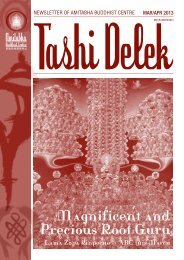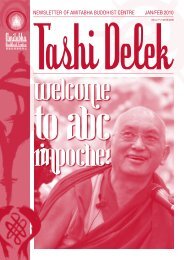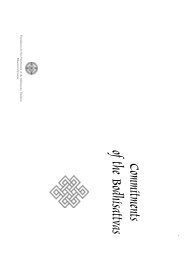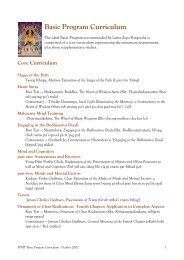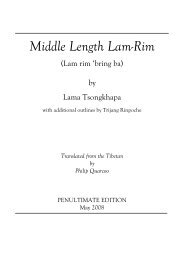It is at this point in the meditation that you reflect on the kindness of sentient beings, both when they wereyour mothers and when they were not. This reflection becomes very helpful because you realise even morereasons <strong>to</strong> cherish others rather than <strong>to</strong> cherish yourself. To give an easy example of the kindness of otherswhen they were not your mothers: the simple fact that we are able <strong>to</strong> gather in this room and enjoy listening <strong>to</strong>the Mahayana Dharma is completely due <strong>to</strong> the kindness of others. Many people put in a great deal of effortso that we can be here. First of all, there may have been another building here that had <strong>to</strong> be <strong>to</strong>rn down, andthat required a number of workers. Then other people worked <strong>to</strong> design the new building and buy thematerials such as bricks, cement and so forth. Other people were needed <strong>to</strong> operate the machines, sincemachines don't work by themselves, and <strong>to</strong> do the actual construction work on the building. Then, when thebuilding was finished, people worked on decorating the interior and collecting the representations of theBuddha's Body, Speech and Mind <strong>to</strong> place on the altar. Therefore, the fact that we can enjoy coming <strong>to</strong>getherhere <strong>to</strong>day and listening <strong>to</strong> the Mahayana Dharma is entirely due <strong>to</strong> the kindness of others, isn't it?The same applies <strong>to</strong> your own home, your belongings, the things you enjoy—all of these are due <strong>to</strong> thekindness of others. You might say, "No, this is not true. I bought my house with my own money; I bought myclothes with my own money." Yes, that is true, but you earned your money on the basis of others. "Okay, I gotthe money from others but this is because I worked hard: I did something <strong>to</strong> receive this money in return." Yes,but the fact that you are able <strong>to</strong> work is because of others, isn't it? If you think about it carefully, you will seethat whatever happiness you now enjoy comes exclusively from the kindness of others.When you reflect on the advantages of cherishing others, it is very effective <strong>to</strong> incorporate all these differentthoughts. You can also contemplate that all the benefits right up <strong>to</strong> the attainment of Buddha's state comeabout because of cherishing others. <strong>How</strong> is this? If you want <strong>to</strong> become a Buddha, you must generate theprecious mind of bodhicitta, because without bodhicitta, there is no Buddha. The generation of bodhiciitacomes about because of the wish <strong>to</strong> benefit others: "I must achieve the state of Enlightenment in order <strong>to</strong>benefit others." Also, the exceptional cause of bodhiciita is great compassion, and great compassion comesfrom cherishing others. Therefore, it is because of others that you generate great compassion.Furthermore, the practice of the six perfections depends on others. For example, you practise morality inrelation <strong>to</strong> others, and in order <strong>to</strong> practise generosity and patience you need an object, and these objects areothers. It is so true what Shantideva taught in the Bodhisattvacharyavatara, when he says,Both the Vic<strong>to</strong>rious Ones and sentient beings are indispensable <strong>to</strong> achieving the supreme enlightenment, andsince I pay homage <strong>to</strong> the vic<strong>to</strong>rs, why don't I pay homage <strong>to</strong> sentient beings as well?This is saying that the achievement of supreme enlightenment is half due <strong>to</strong> the kindness of the Buddhas andhalf due <strong>to</strong> the kindness of sentient beings. When we give so much importance <strong>to</strong> honouring the Buddhas,why don't we give the same importance <strong>to</strong> honouring the sentient beings who are equally indispensable <strong>to</strong> ourachievement of enlightenment? As the great master Langri Tangpa says in his Eight Verses of ThoughtTransformation,I can achieve the supreme state of enlightenment due <strong>to</strong> the kindness of sentient beings, therefore they aremore precious than a wish-fulfilling jewel and I should cherish them <strong>to</strong> that extent.There are so many heart-warming instructions on the kindness of sentient beings.This great master Tangri Langpa was so exceptional, he was truly a superior being. (By the way, he is in theline of the previous incarnations of the late Kyabje Trijang Rinpoche.) It is said that Langri Tangpa was alwaysvery serious and smiled only three times in his whole life, so he was known as "Langri Tangpa of the blackface" (in Tibetan the term "black face" means "serious"). He spent all of his time meditating on thedisadvantages of cyclic existence and bodhicitta, and that is why he didn't find many occasions <strong>to</strong> laugh.I'll tell you the s<strong>to</strong>ry of one of the three occasions when Langri Tangpa laughed and what made him laugh.This s<strong>to</strong>ry is about his mandala set. In the Kadampa tradition and in the tradition of Lama Pabongka DorjeChang, the practice of offering the mandala is very much emphasized. When I was young in Tibet, most of uswould bring our mandala sets <strong>to</strong> teachings, so that at the point of offering the mandala very few would bewithout one. In the row of the tulkus [reincarnated lamas], each tulku would have his own beautiful mandalaset—some made of gold, some of silver—but the <strong>to</strong>p would always be of gold. It was quite scene when all thetulkus offered their mandalas! But that was in the past, and then at a certain point everything was taken away.My own mandala set was taken away. There is also a particular implement used <strong>to</strong> offer the hundred <strong>to</strong>rmas,
which is a kind of flat container decorated with symbols. I had one of these because the Kadampa traditionplaces so much emphasis on the practice of offering <strong>to</strong>rmas, but that was taken away as well. By "takenaway" I mean confiscated by the Communists. Nowadays, I use something very simple.Anyway, one day Langri Tangpa was meditating, and he had his mandala set on the table next <strong>to</strong> him. It wasprobably a simple mandala set, not a beautiful or elaborate one. As he was meditating, he noticed that amouse had come and was eating some of the grains of his mandala. Among the grains was a big turquoiseand for some reason, the mouse was attracted <strong>to</strong> the turquoise and started <strong>to</strong> pick at it, trying <strong>to</strong> get hold of it,but it was <strong>to</strong>o big for him. Then another mouse came and began helping the first one, so both of them weretrying <strong>to</strong> get hold of it. Pretty soon there were five mice and they devised a way <strong>to</strong> get the turquoise: onemouse laid on his back and held the turquoise on his s<strong>to</strong>mach, and the other four mice held his head and legsand were pulling him along. Langri Tangpa had been watching the mice and when he saw this he broke in<strong>to</strong> aslight laugh. Why did he laugh? Because he thought that in cyclic existence when it comes <strong>to</strong> fulfilling one'sneeds, animals are more clever than human beings. It's true, sometimes animals can be smarter than humanbeings in taking care of the needs and happiness of this life.The Actual Thought of Exchanging Oneself with OthersSo now we come <strong>to</strong> the fourth step in the meditation, which is the actual thought of exchanging oneself withothers. What is meant by exchanging oneself with others? Prior <strong>to</strong> this, we contemplated deeply thedisadvantages of cherishing oneself, realising that all unwanted experiences and bad things come fromegoism. Like a chronic disease which slowly, gradually destroys your health and physical form, the selfcherishingthought has, from beginningless time, been the source of all your suffering and problems. On theother hand, all the good things—good qualities, happiness, advantages and so forth—derive from cherishingothers, from altruism. Realising this, you now begin <strong>to</strong> train your mind in exchanging the thought whichcherishes oneself and disregards others for the thought which cherishes others and disregards yourself.Until now we have been disregarding others and taking care of ourselves, but from now on, we have <strong>to</strong> takecare of others and disregard ourselves. Exchanging oneself with others doesn't mean that you take others inyour place and put yourself in others' place. Instead it means that you exchange the mind which cherishesoneself and ignores others with the mind which cherishes others and ignores oneself. You need <strong>to</strong> meditateon this again and again, continuously, and in this way train your mind in exchanging yourself with others.The Meditation on Giving and Taking (Tong-Len)On the basis of the thought of exchanging oneself with others, you practise the meditation on giving andtaking. What is giving and taking? With the mind of compassion you take on the suffering of others and withthe mind of love you give them happiness. The root text of The Seven-Point Thought Transformation says,"giving and taking should be practised alternately." In the Tibetan term, <strong>to</strong>ng-len, giving comes first—<strong>to</strong>ngmeans "giving" and len means "taking"—but in actual practice, you first train your mind in taking—taking uponyourself the suffering of others—and leave aside the practice of giving.TakingYou begin the practice of taking by contemplating the sufferings of the precious mother sentient beings untilan unbearable sense of compassion arises within you. Then you visualise that suffering in the aspect of blacklight, which separates from the sentient beings in the same way that hairs separate from your skin when youshave. You visualise that this suffering in the aspect of black light comes and absorbs in<strong>to</strong> the self-cherishingthought which is at the centre of your heart.You can do the meditation in an elaborate way, going one by one through all the different realms of thesentient beings, starting from the hells. For example, you can think about the sufferings of sentient beings inthe hot hells—sufferings due <strong>to</strong> the intense heat, fire and so forth—and then take upon yourself this sufferingin the form of hot fire, visualising that it absorbs straight in<strong>to</strong> the centre of your heart, in<strong>to</strong> the egoistic, selfcherishingthought.You continue <strong>to</strong> meditate in this way, gradually progressing through all the different levels and kinds ofsentient beings all the way up the bodhisattvas of the tenth bhumi, taking all their suffering in<strong>to</strong> the centre ofthe self-cherishing thought in your heart. You take on not only their sufferings but all the obscurations and






